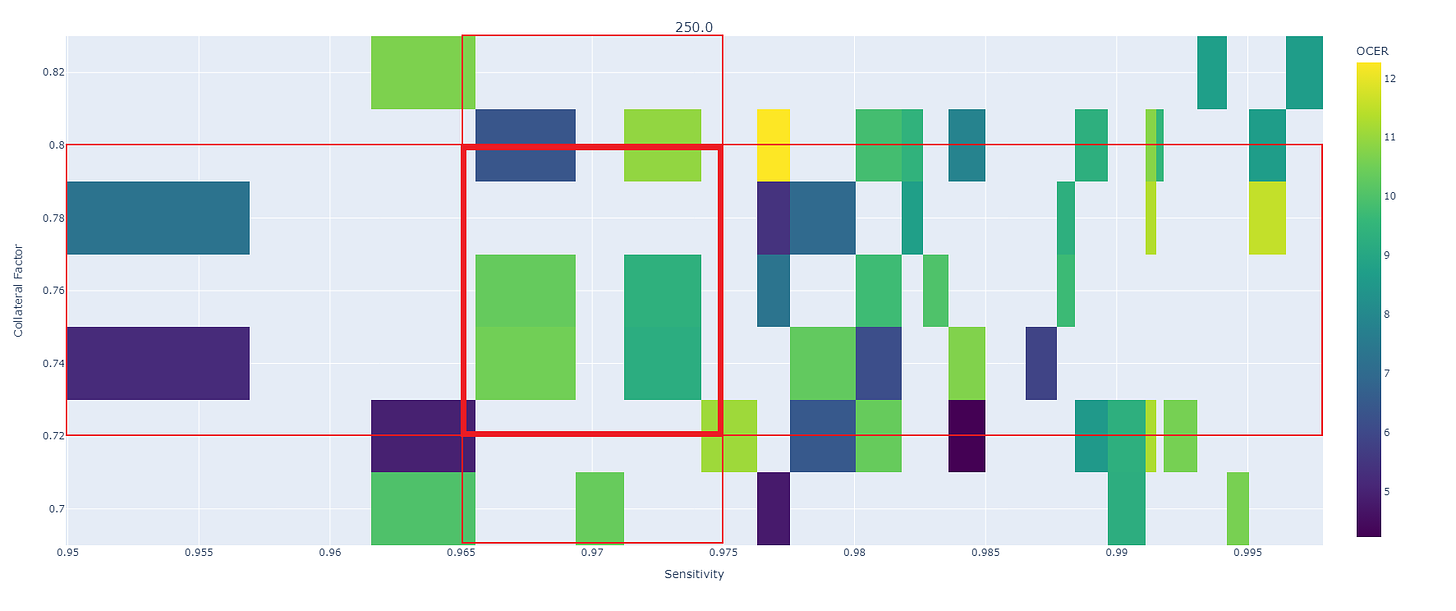Arcadia Collateral Risk Simulation: Final Report
An Introduction to ArcadiaSim and initial recommendations for Arcadia V2
Previous Reports
Report 1 - February 9
Report 2 - February 14
Report 3 - Feburary 21
Report 4 - February 27
Report 5 - March 6
We are pleased to announce the successful delivery of ArcadiaSim, a sophisticated risk simulation tool specifically designed to parameterize the Arcadia v2 collateral set. This development marks a significant milestone in our journey towards enhancing the robustness and efficiency of Arcadia v2. It's particularly exciting to validate our simulation tool in production, as Arcadia v2 has been deployed just this week.
Where we started
We initiated our partnership with Arcadia at the beginning of February to develop a simulation tool that would parameterize the Arcadia v2 protocol. After our 10-week engagement, we have now successfully arrived at a parameter recommendation for the initial collateral set.
How we arrived at our recommendations
Our methodology involved a comprehensive approach to optimize the parameters of the Arcadia protocol. The goal was to strike a balance between the maximization of protocol revenue with the minimization of bad debt. This is a crucial consideration for the protocol's financial health and operational efficiency while providing the optimal user experience.
At the core of the methodology, we use specific metrics to gauge the effectiveness of different parameter settings. These include:
Net Protocol Revenue: A measure of the total financial gain from liquidation processes, providing a clear picture of the protocol's profitability.
Net Protocol Bad Debt: Represents the total financial loss from accounts that become insolvent, offering a snapshot of the financial risks faced by the protocol.
Operational Stress/Efficiency Ratio (OSER): A custom metric designed to evaluate the balance between the protocol's revenue and bad debt in relation to the Collateral Factor and the number of liquidated accounts. It serves as an innovative metric to measure the operational efficiency and financial stress experienced by the protocol under various scenarios.
Operational Stress/ Efficiency Coefficient (OSER)
In addressing the optimization challenge between conflicting interests within the Arcadia protocol, we navigated the delicate balance between safeguarding borrowers from being liquidated due to minor price fluctuations and the imperative to maximize protocol revenue. The inherent conflict arises from the need to maintain a narrow sensitivity ratio, defined as the quotient of the collateral factor and the liquidation factor, which directly impacts both borrower security and protocol profitability. To effectively mediate this conflict, we introduced the Operational Stress/Efficiency Ratio (OSER), a custom cost metric designed specifically to balance these competing interests.
We aim to calculate the Operational Stress/Efficiency Ratio (OSER) using the formula:
Where:
revenueis the total revenue generated.bad_debtis the total amount of bad debt.CF(Collateral Factor) adjusts the net revenue based on the stability of the collateral.sensitivityadjusts the calculation based on market conditions.no_of_liquidated_accountsis the total number of liquidated accounts conducted.total_debtis the total debt amount for the period being analyzed.
The metric minimizes total_debt and no_of_liquidated_account representing borrower interest by avoiding aggressive liquidation factors while, on the other hand, representing protocol interest by maximizing profit (i.e. revenue - bad_debt). Collateral Factor and sensitivity enable comparability across scenarios.
Simulation Environment and Agents
The simulation environment is a sophisticated framework that replicates the dynamic interactions within the Arcadia protocol. It includes:
Simulation Setting: This custom setting allows for the creation of a virtual ecosystem that mirrors the Arcadia protocol, incorporating agents' behaviors, market conditions, and protocol parameters.
Agent Behavior Modeling: The simulation categorizes agents into borrowers, liquidators, and (implicitly) lenders. Borrowers are modeled based on empirical distributions to reflect realistic borrowing behaviors. Liquidators, on the other hand, are programmed to act based on profit maximization strategies, which include assessing the cost and benefits of liquidating positions.
Scenarios Selection
A critical aspect of the methodology is the selection and analysis of scenarios, especially focusing on market price shocks. The scenarios are crafted to test the resilience of the protocol under extreme market conditions. This includes evaluating the protocol's performance during significant market downturns and assessing the impact of liquidity constraints on the protocol's operations.
Example: OSER Analysis of cbETH-USDC
In this segment, we thoroughly analyze our findings for the cbETH-USDC single asset allocations, illustrating the methodology that underpinned our recommendations. Our analysis dissects the results, emphasizing the pivotal insights and analytical strategies that shaped our strategic recommendations. Central to our evaluation is the application of the Operational Stress/Efficiency Ratio (OSER). This key metric played a significant role in navigating the complexities of optimizing protocol parameters for this specific asset pairing.
cbETH-USDC
In reviewing the OSER heatmap data for the cbETH (Collateral) and USDC (Numeraire) pairing, we observe a delineated zone within the high-OSER value range. The thick red square, strategically positioned, signifies the selected region that aligns with our objective to capitalize on high OSER values while steering clear of lower-valued regions.
The heatmap's color gradation transitions from cooler to warmer tones. While bright colors are seen on the right side, there is a lack of data for the selected collateral factor range. Henceforth, this leads us to the conclusion of the range defined within the bold square. Based on this, we define the collateral factor range from 0.72 to 0.8 and the accompanying sensitivity range from 0.965 to 0.975.
Recommendations for Protocol Parameters
Based on the outcomes of the simulations across various scenarios and asset numeraire pairs, we conclude with specific recommendations for setting the CF and LF. These recommendations aim to ensure the protocol can achieve its dual objectives of maximizing revenue while minimizing bad debt.
Non-correlated Pairs
Upon review of non-correlated asset numeraire pairs, the simulation output generally suggests more conservative values with a larger buffer.
These values translate into the following ranges for the collateral factor and liquidation factor:
Correlated Pairs
Upon review of correlated asset numeraire pairs, the simulation output generally suggests more aggressive values with a smaller buffer.
These values translate into the following ranges for the collateral factor and liquidation factor:
UniswapV3 LP Token
Risk parameters for LP pairs are set by the lower risk metrics of the two assets, applying a correction multiplier of 1 or less. For a USDC-WETH pair, assuming USDC at 80-90% and WETH at 90-95% risk, the parameters are set at 80% for collateral and 90% for liquidation. Henceforth, LP recommendations are fundamentally reliant on single-asset results and should be inferred from the tables above.
What's next
As we conclude this series in optimizing protocol parameters for the Arcadia protocol, our journey does not end here. Looking ahead, we are excited about the future and committed to advancing our work in several key areas to ensure the ongoing economic security and robustness of the Arcadia protocol against the backdrop of ever-evolving market conditions.
Firstly, we are enthusiastically open to handling additional projects. Our team is ready to apply our expertise and the insights gained from the Arcadia project to new challenges, expanding our impact across the DeFi ecosystem. By leveraging our refined methodologies and simulation tools, we aim to contribute to the resilience and efficiency of other protocols.
Continuing improvement of our simulation framework is at the forefront of our agenda. The Arcadia simulation project has laid a solid foundation, but we recognize the potential for further enhancements. Our team is dedicated to refining our models, incorporating more granular data, and integrating advanced analytical techniques. These improvements will enable us to capture the nuances of protocol dynamics more accurately, ensuring that our recommendations remain at the cutting edge of DeFi risk management practices.
Lastly, our commitment to Arcadia's success and security is unwavering. As we forge ahead, new insights and improvements gleaned from our ongoing research and simulation enhancements will be shared with Arcadia and its community through a public risk portal. The dashboard will regularly update with current market data to proactively identify potential threats to the protocol's health. This continued collaboration is key to ensuring that Arcadia remains adaptive and secure amidst the shifting sands of market conditions. Our goal is to provide Arcadia with actionable intelligence that supports its continuous evolution, safeguarding its economic security for the long term.
In summary, the path ahead is one of expansion, innovation, and deepened collaboration. We are poised to tackle new projects, enhance our simulation framework, and share our evolving insights with Arcadia and beyond. By doing so, we aim to contribute to the development of more resilient, efficient, and secure DeFi protocols, ready to meet the challenges of an ever-changing financial landscape.










